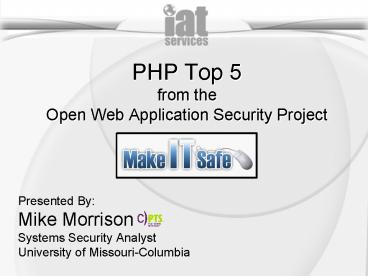PHP Top 5 from the Open Web Application Security Project - PowerPoint PPT Presentation
1 / 22
Title:
PHP Top 5 from the Open Web Application Security Project
Description:
Persistent Attacker stores malicious content in victim database ... note: Even better code would check for length, type and syntax if the input ... – PowerPoint PPT presentation
Number of Views:238
Avg rating:3.0/5.0
Title: PHP Top 5 from the Open Web Application Security Project
1
PHP Top 5from the Open Web Application Security
Project
- Presented By
- Mike Morrison
- Systems Security Analyst
- University of Missouri-Columbia
2
PHP Trivia
- Name the Danish-Canadian programmer credited with
creating PHP. - Rasmus Lerdorf (1994)
3
Overview
- Past Techniques Misconceptions
- The Top 5
- QA
4
Past Techniques Misconceptions
- What is the cure for vulnerable PHP apps?
- Firewalls/IDS/IPS can not be relied on
- Input validation is the key
- Know your PHP configuration
- Only through code reviews and ensuring that code
is tested for security flaws can the risk of
attack be reduced.
5
Past Techniques Misconceptions
- safe_mode
- Tests for UID/GID restricts system()
- Many believe if this is enabled PHP is locked
down - Majority of PHP vulnerabilities bypass safe_mode
- Removed from PHP 6!
6
Past Techniques Misconceptions
- addslashes() / magic_quotes
- Does not prevent all SQL injection attacks
- Use safer mechanisms like PDO or
mysql_real_escape_string - PDO requires PHP 5.1 or greater
- Removed from PHP 6!
7
1 Remote Code Execution
- Most widespread issue since 2004
- Hackers are able to execute processes on the end
system. - Causes
- Insufficient validation
- Use of PHP wrappers
- Poor privilege management
8
1 Remote Code Execution
- Vulnerable Functions
- See Code Example
9
1 Remote Code Execution
10
1 Remote Code Execution
- Countermeasures
- Server-side white list input validation!
- Limit use of dynamic inputs to vulnerable
functions - Review code for file operations
- Disable allow_url_fopen in php.ini
- For now Enable safe_mode restrictions and set
open_basedir restrictions
11
2 Cross-Site Scripting
- Three Types of XSS
- Reflected Attacker provides link containing
malicious content (primary form of phishing via
e-mail) - Persistent Attacker stores malicious content in
victim database - DOM Uses victim sites JavaScript code to
reflect XSS attack
12
2 Cross-Site Scripting
- Causes
- Insufficient validation
- Systems with register_globals turned on are more
at risk - See Code Example (Reflected XSS)
13
2 Cross-Site Scripting
note Even better code would check for length,
type and syntax if the input does not pass all
checks the application should display a generic
error and die.
14
2 Cross-Site Scripting
- Countermeasures
- Server-side white list input/output
validation!(check for length, type, syntax) - Properly initialize inputs and other variables
- Turn off register_globals
- Use htmlentities() to scrub data bound for
browser - Obtain input directly from correct location
(_POST, _GET, etc.) - Remove canned apps known to be vulnerable
15
3 SQL Injection
- Causes
- Insufficient validation
- Countermeasures
- Use PHP 5.1 PHP Data Objects (PDO)
- Use MySQLi or PEARDB parameterized statements
- At very least use a function like
mysql_real_escape_string
16
3 SQL Injection
See longer example on OWASP Top 5 page which
uses PHP Data Objects (PDO)
17
4 PHP Configuration
- Secure PHP configuration standards are an ongoing
debate - Improperly configured PHP can expose system to
unnecessary risk - Rule of thumb if youre not using it turn it
off
18
4 PHP Configuration
- Best Practices
- Disable the following (php.ini or .htaccess)
- Enable and correctly configure safe_mode and
open_basedir (Beware, safe_mode isnt exactly
safe!) - Upgrade to PHP 5
- Stay informed, visit OWASP often!
19
5 File System Attacks
- Types
- Local file inclusion (/etc/passwd, conf files,
logs) - Local session tampering(usually looking at files
in /tmp) - Local file upload injection(primarily a
vulnerability in attachment handling)
20
5 File System Attacks
- Check your code
- Are user inputs included in any file operations?
- Are there variables involved in the operation
that were not initialized? - Is register_globals enabled?
- If so you may be at risk
21
5 File System Attacks
- Countermeasures
- Server-side white list input validation!(check
for length, type, syntax) - Properly initialize inputs and other variables
- Move secrets and logs out of web root
- Make scripts compatible with safe_mode
restrictions and/or use suPHP, PHPsuExec or
php_suexec - Configure SELinux
22
- For the PHP Top 5 Wiki and other OWASP
information seehttp//www.owasp.org/index.php/PHP
_Top_5 - For the Security Awareness Website visit
- http//iatservices.missouri.edu/security/make-it-s
afe/ - To report network vulnerabilities or incidents
email abuse_at_missouri.edu - For questions about the information in this
presentation or to join the PHP Birds of a
Feather you may email - morrisonm_at_missouri.edu































